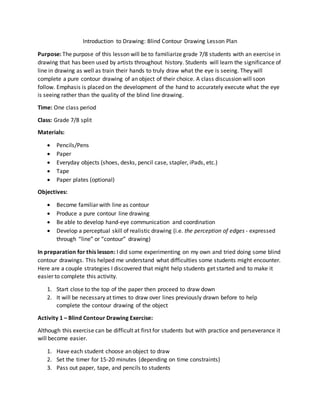
Learn Blind Contour Drawing
- 1. Introduction to Drawing: Blind Contour Drawing Lesson Plan Purpose: The purpose of this lesson will be to familiarize grade 7/8 students with an exercise in drawing that has been used by artists throughout history. Students will learn the significance of line in drawing as well as train their hands to truly draw what the eye is seeing. They will complete a pure contour drawing of an object of their choice. A class discussion will soon follow. Emphasis is placed on the development of the hand to accurately execute what the eye is seeing rather than the quality of the blind line drawing. Time: One class period Class: Grade 7/8 split Materials: Pencils/Pens Paper Everyday objects (shoes, desks, pencil case, stapler, iPads, etc.) Tape Paper plates (optional) Objectives: Become familiar with line as contour Produce a pure contour line drawing Be able to develop hand-eye communication and coordination Develop a perceptual skill of realistic drawing (i.e. the perception of edges - expressed through “line” or “contour” drawing) In preparation for this lesson: I did some experimenting on my own and tried doing some blind contour drawings. This helped me understand what difficulties some students might encounter. Here are a couple strategies I discovered that might help students get started and to make it easier to complete this activity. 1. Start close to the top of the paper then proceed to draw down 2. It will be necessary at times to draw over lines previously drawn before to help complete the contour drawing of the object Activity 1 – Blind Contour Drawing Exercise: Although this exercise can be difficult at first for students but with practice and perseverance it will become easier. 1. Have each student choose an object to draw 2. Set the timer for 15-20 minutes (depending on time constraints) 3. Pass out paper, tape, and pencils to students
- 2. 4. Have each student tape a piece of paper to their desk so that it doesn’t shift as they draw 5. Before students begin, demonstrate to them how to do a quick 1 minute contour drawing. Emphasising that the drawing will not be high-quality. If students are still unsure, show the following link https://www.youtube.com/watch?v=FKHVqbM_xLU 6. Arrange students so that they can see the object they will be drawing without seeing the paper 7. Allow students to focus their eyes on some part of the object; moving their pencil to record what their eyes observe 8. Make sure that students do not peek at the paper as they draw; concentrating on how the shapes, lines, and contours of the object relate to one another a. Use paper plates which block students from looking at their contour drawing 9. Make sure that the students don’t rush. They should concentrate on observing every little detail. 10. Make sure students continue to draw until the timer signals themto stop. Then allow them to turn and look at their drawing. 11. Make sure students sign and date their work and place it in their art folder 12. Pause for reflection after the students complete their blind contour drawing. Ask students to reflect on what they see versus what is being produced on the paper. Can they see some formation of the objects they are attempting to draw? Are some parts of their drawing amazingly accurate? Did they find that some parts of their object were far better drawn? Did they find it useful? Freeing? Would they do it again? 13. Have students walk around the classroom to see other students blind contour drawings so that they may see that all struggle with this exercise 14. *If there is time still remaining, allow students to continue to practice pure contour drawing by using other objects that they have not used until the bell rings Summary: Blind contour drawing is an excellent way to train the eye to draw what it really sees rather than what it thinks it sees. The reason most people have difficulty drawing realistically is not because of any lack of physical skill or talent but because they have not been trained to really look at what they see.